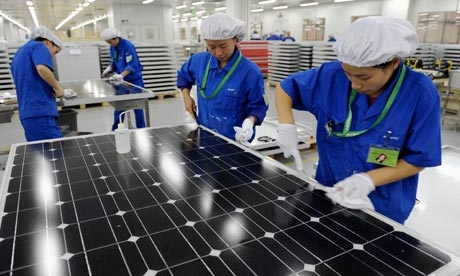Last month, the European Union set provisional tariffs on Chinese solar products, with the intent to raise the rate five times come August. At present, the rate is 11.8 percent, and this move affects nearly solar panels worth nearly $15 billion.
The Chinese makers of these panels hope to circumvent the high tariffs by shifting production and assembly over to various places, including South Africa and Istanbul, reports Bloomberg.
 Thus far, companies that have begun preparations to move manufacturing out of China include Trina Solar Ltd. (NYSE: TSL), JinkoSolar Holding Co. (NYSE: JKS), and Canadian Solar Inc. (NASDAQ: CSIQ). The European move is seen largely as an effort to combat “dumping” of Chinese-origin solar panels in international markets, similar to tariffs the U.S. had imposed on Chinese panels.
Thus far, companies that have begun preparations to move manufacturing out of China include Trina Solar Ltd. (NYSE: TSL), JinkoSolar Holding Co. (NYSE: JKS), and Canadian Solar Inc. (NASDAQ: CSIQ). The European move is seen largely as an effort to combat “dumping” of Chinese-origin solar panels in international markets, similar to tariffs the U.S. had imposed on Chinese panels.
It will affect major companies like Yingli Green Energy Holding (NYSE: YGE), which is at present the largest solar panel maker in the world, as well as other manufacturers of silicon-based panels, solar cells, and wafers.
This is a somewhat worrying situation. Until now, China has had a good relationship with the European region as far as the solar sector was concerned. China is the world’s largest maker of solar products, and the EU is the world’s largest solar market. As of 2012, this productive relationship was worth $569 billion.
Now, Jinko is looking to set up manufacturing operations in South Africa and Portugal. Canadian Solar is looking toward Taiwan, Malaysia, and Thailand. Officials from both China and the EU have expressed a desire toward resolving the situation without resorting to open animosity, but it remains unclear how far that may go.
This is undoubtedly unwelcome news to China, which is currently dealing with a developing crisis in domestic manufacturing. As of this current month, it is contracting at rates faster than predicted. Just recently, the People’s Bank of China issued a warning to domestic banks to rein in poor lending practices in an effort to stave off a potential liquidity crisis.
Avoiding the Tariff
Other companies might want to follow the example set by Suntech Power Holdings Co. Ltd. (NYSE: STP), which has said that it will develop “tariff-free” versions of its solar products. These products will be manufactured outside China, thus satisfying (or at least bypassing) the new tariff requirements.
Canadian Solar is investigating its options for shifting manufacturing over to South Africa, Saudi Arabia, or even Turkey. And China Sunergy Co. (NASDAQ: CSUN) has already begun shipments from a plant located in Istanbul.
Should the ongoing talks between China and Europe peter out, August 6 will see a sharp increase in tariffs to 47.6 percent, and European governments may then deliberate over whether to make the new rates stable for the next five years or not.
This is actually bad news for European solar developers. Given the recent lackluster demand and oversupply problems, the costs for them were bound to decrease in the near future. With the new tariffs, that’s all but impossible.
China hasn’t been slow to respond to the EU’s move against its solar products, though. China has initiated an anti-dumping and anti-subsidy probe into European wine exports to China, reports Reuters. It appears China’s newly-growing wealthy classes want their Bordeaux—the nation ranks as the world’s top importer of that variety. 2011 saw consumption of Bordeaux in China jump by 110 percent.
Clearly, the EU will have taken note of these trends, and this move makes it likely that a solution will be found to the solar issue achieving some sort of compromise. However, at least initially, the EU has unanimously pledged to defend its wine exporters, which doesn’t strike a very conciliatory tone.
{$custom_solar_2}
GE Sees Solar Opportunities in China
Meanwhile, General Electric Power Conversion (NYSE: GE) has decided to wade into the Chinese solar sector, in partnership with Sinoma International Engineering Co., Ltd. and Yingda International Leasing Co., Ltd.
Thus far, the domestic solar sector has done well, although there has been a spate of consolidations and bankruptcies in recent times. However, China remains committed to reducing emissions and energy use per unit of GDP by a minimum of 3.7 percent over the year.
The nation also continues its efforts to raise to 10 gigawatts its installed solar photovoltaic capacity over this year. Altogether, China is set to invest as much as $645 billion in its solar sector. Clearly, GE sees major opportunities here.
GE will provide a range of central inverters that are vital to the solar sector. The ProSolar Converters function well in utility-scale settings and can readily handle more than 1,000 Volts in input voltage.
From GE’s press release, quoting GE Power Conversion China president Bo Liu:
“China is already one of the largest solar energy users as well as a leading producer of PV hardware globally. The opportunity for growth in clean and efficient solar energy is immense as China aggressively pursues a reduction in carbon emissions. This partnership brings together the best of the capabilities needed to deliver powerful, reliable and cost-effective solutions, which we expect will become the trademark for other regions to benefit from.”
If you liked this article, you may also enjoy:




